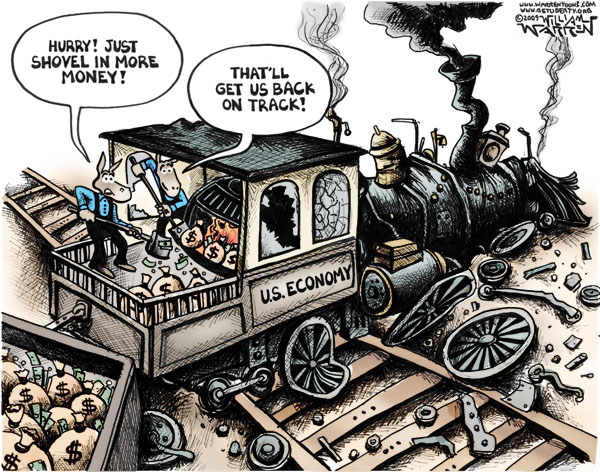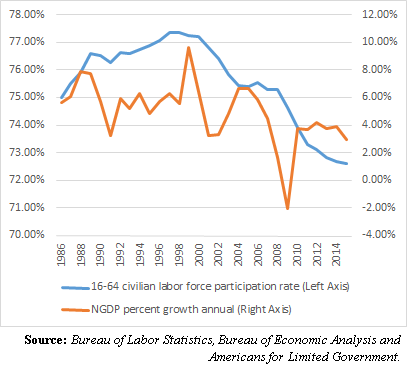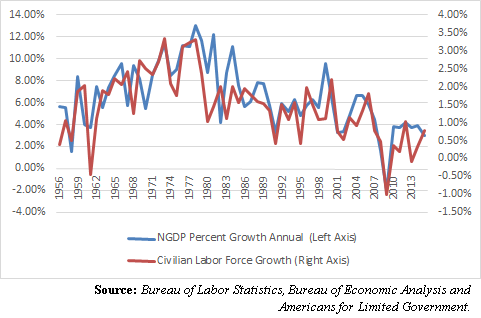Since 1997, at the height of the dotcom bubble, labor participation of 16 to 64 year olds — that is, those working or looking for work — has been declining almost every single year even as the population has increased.
As a result, the rate has fallen from about 77.37 percent to just 72.61 percent in 2015 according to data compiled by the Bureau of Labor Statistics, accounting for almost 10 million people who either left the labor force or never entered on a net basis since then.
This had followed an overall expansion of the U.S. labor force since the 1950s as women entered the workforce. But at the start of the 21st Century, something changed.
Male participation continued to decline, as it has for more than 60 years, and female participation began to decline too. Younger workers, middle-age workers, it didn’t matter. Participation is now down across the board for almost two decades.
Note this particular leg of the analysis excludes those over the age of 65, Baby Boomers who are undergoing a retirement wave that that has the effect of lowering labor participation.
That is because there is a real dilemma facing the working age population of 16 to 64 years old, since those are the prime working years and whose exit from the labor force may be the most troublesome from an economic standpoint.
Namely, because the decline in labor participation has coincided with the slowdown of the U.S. economy, which has not grown above an inflation-adjusted rate of 4 percent since 2000, and not above 3 percent since 2005.
Historically, there has been a strong relationship between the growth of the overall labor force and the growth of the economy itself. Periods where the labor force has expanded have correlated with periods of growth, and vice versa.
That is particularly worrisome, because the Bureau of Labor Statistics is projecting even further declines in labor participation through 2024 in a study it publishes once every two years.
In “Labor force projections to 2024: the labor force is growing, but slowly” the Bureau has the overall labor participation rate dropping from its current level of 62.7 percent to 60.9 percent in 2024, and from 72.61 to 72.58 percent for 16-64 year olds.
One can only hope this projection is wrong. Whether the weaker economy is leading to the labor force decline, or the shrinking labor pool as a percent of the population is what is holding back the economy, or both, the implication of the forecast is clear. Going forward, the U.S. should expect even weaker growth in the Gross Domestic Product than it has even for the past decade, which was already pretty bad.
But why? Why has labor participation been dwindling? And why will it keep shrinking? Unfortunately, the Bureau report does not shed much light on the topic, except to note that participation rates have been declining for some time now, and are expected to continue declining into the future.
Looking to other quarters, in a 2004 speech then-Federal Reserve Chairman Ben Bernanke noted the declining participation rate as a function of stronger productivity: “strong productivity gains allow firms to meet a given level of demand with fewer employees.”
Which makes a whole lot of sense. For example, if you are reading this article, you’re undoubtedly doing so from a computer or smart phone. Thanks to automation and computers in particular, many of the tasks that once took many employees to complete can now be done with far fewer workers. That was about the time computers were becoming exceedingly powerful.
Other factors may include outsourced production to emerging markets for particular sectors, including manufacturing. 2000 does mark the year China was granted permanent normal trade relations, right about the time the labor force participation decline began.
There’s also the high cost of doing business in the U.S. induced by the high tax, regulatory environment and also greater property values and labor costs that could result in shifting production overseas.
Also, demographic shift. As Baby Boomers retire, so are many small businesses and legacy jobs, which are not being replaced.
Then, there’s also public assistance. In 2012, the Obama administration did waive the Temporary Assistance for Needy Families work requirements that were the heart of welfare reform in the 1990s. By then, the labor participation decline was already well under way. To the extent the policy discourages welfare recipients from seeking work, that could also help keep labor participation artificially lower than it otherwise might be.
Adding to the government dependency factor, the decline in labor force participation coincided with some pretty bad recessions, which as saw an uptick in those seeking unemployment benefits, disability, food stamps and the like. But that may be a symptom of the weak economy itself as much as the government’s counter-cyclical expansion of eligibility for those programs.
If the economy is not so great, why should it be producing more jobs?
Still, there appears to be a combination of factors that is leading to a decline in demand for labor in the U.S., which has coincided with a slowing of growth and even a flattening of incomes.
And since the implications of further declines in labor participation are a toxic mix of even slower growth, fewer jobs and greater dependence on public assistance, for the growing millions of people who cannot find work — 10 million and counting since the century began — it’s hard not to see this simply as a lost generation of opportunity. The next administration must figure out a way to get America back to work.
Robert Romano is the senior editor of Americans for Limited Government.










